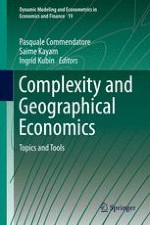2015 | OriginalPaper | Buchkapitel
Towards a Multiregional NEG Framework: Comparing Alternative Modelling Strategies
verfasst von : Pasquale Commendatore, Valerio Filoso, Theresa Grafeneder-Weissteiner, Ingrid Kubin
Erschienen in: Complexity and Geographical Economics
Aktivieren Sie unsere intelligente Suche, um passende Fachinhalte oder Patente zu finden.
Wählen Sie Textabschnitte aus um mit Künstlicher Intelligenz passenden Patente zu finden. powered by
Markieren Sie Textabschnitte, um KI-gestützt weitere passende Inhalte zu finden. powered by
